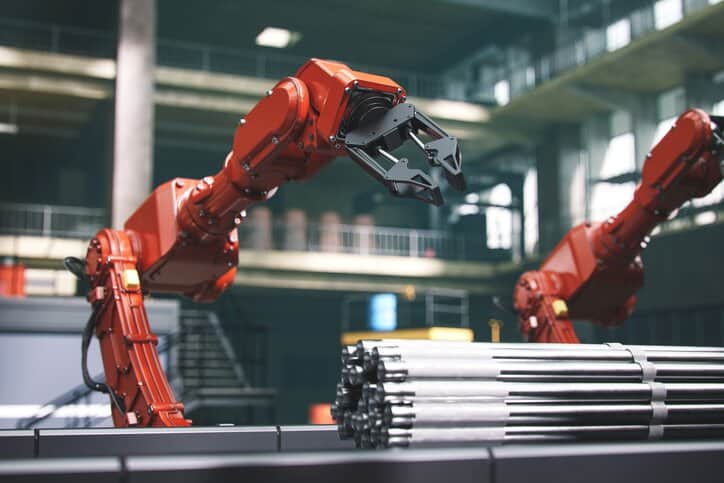Industrial robots and robot cells are crucial in manufacturing because they significantly enhance productivity, quality control, and safety by automating repetitive tasks. With the increasing adoption of robotics in manufacturing and other industrial sectors, assuring these machines operate safely and efficiently is paramount. ISO 10218-2:2025—Robotics – Safety requirements – Part 2: Industrial robot applications and robot cells outlines safety requirements for industrial robot applications and industrial robot cells.
Difference between Industrial Robots and Robot Cells
An industrial robot is a machine that performs tasks in factory that that require speed, accuracy, and consistency. On the other hand, a robot cell is a workspace that contains robots and is better suited for tasks that require mobility, flexibility, and human compatibility.
Industrial robots are often used in robot cells to perform automated tasks. The cell itself is designed to keep employees safe by preventing them from interacting with the robot while it is operating. Robot cells can be equipped with safety devices that detect when a person or object enters the workspace and stop the robot.
What Is ISO 10218-2?
ISO 10218-2:2025 specifies requirements for the integration of industrial robot applications and industrial robot cells. The international standard helps to assure that robots are designed safely and efficiently—posing minimal risk to people and the industrial environment. ISO 10218-2:2025 addresses the following:
- The design, integration, commissioning, operation, maintenance, decommissioning and disposal
- Integration of machines and components
- Information for use for the design, integration, commissioning, operation, maintenance, decommissioning, and disposal
This document deals with the significant hazards, hazardous situations, or hazardous events when use intended and under specified conditions of misuse which are reasonably foreseeable by the integrator.
If you want to learn more about the first part of this standard (ISO 10218-1), you can check out our blog post: ISO 10218-1:2025—Robots And Robotic Devices Safety.
What Is Not in the Scope of ISO 10218-2?
ISO 10218-2:2025 is not applicable to the following uses and applications of industrial robots:
- Underwater
- Law enforcement
- Military (defense)
- Airborne and space, including outer space
- Medical
- Healthcare of a person
- Prosthetics and other aids for the physically impaired
- Service robots, which provide a service to a person and as such the public can have access
- Consumer products, as this is household use to which the public can have access
- Lifting or transporting people
- Multi-purpose lifting devices or machinery, e.g., cranes, forklift trucks
Importance of Industrial Robots
Industrial robot applications allow for consistent high-quality output while reducing labor costs and minimizing human exposure to hazardous environments. Robot cells further optimize workflow by integrating multiple functionalities like assembly, welding, and inspection within a dedicated workspace, leading to streamlined production processes.
Robot applications enable efficiency and productivity boost, cost saving, quality improvements, and increased safety.
Applications of Industrial Robots
Industrial robots are programmable machines that perform tasks in industrial settings, such as manufacturing, assembly, quality control, and material handling. The applications of industrial robots include:
- Assembly: Assemble products
- Welding: Join metal surfaces by melting them with a large current
- Painting: Paint products to improve quality and consistency
- Inspection: Inspect products for quality
- Packaging: Pack and palletize products
- Material handling: Move, pack, and select products
- Disassembly: Disassemble products
- Pick and place: Pick and place products
- Grinding: Remove unwanted material from a product
- Deburring: Remove rough edges from a product
- Polishing: Polish a product’s surface
Applications of Industrial Robots and Robot Cells
Robot cells are automation solutions that can perform complex tasks (that traditional automated machines cannot) by using industrial robots. The application of robot cells, include welding, painting, assembly, palletizing, and quality control.
ISO 10218-2:2025—Robotics – Safety requirements – Part 2: Industrial robot applications and robot cells is available on the ANSI Webstore as well as in the following Standards Package, ISO 10218 – Robots and Robotic Devices Safety Package.
